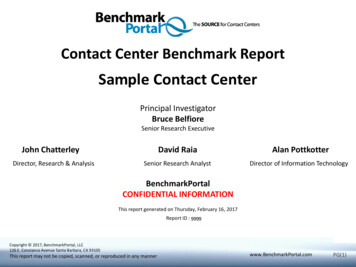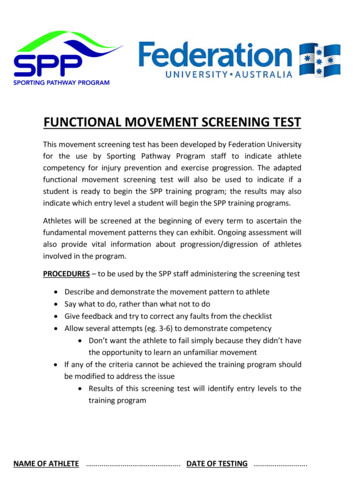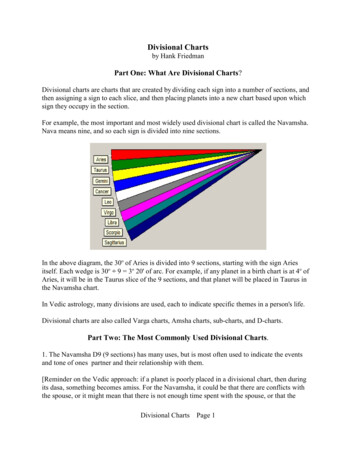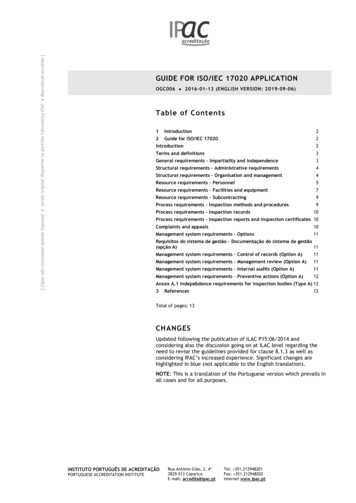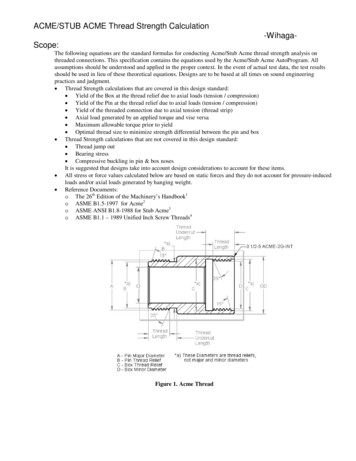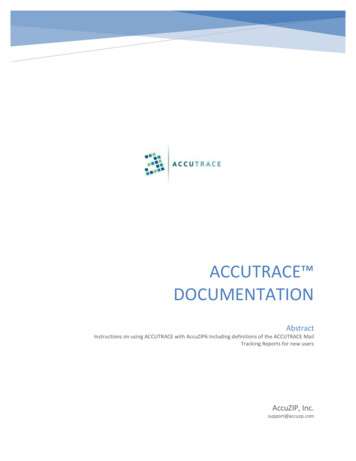
Transcription
A STUDY TO INDICATE THE IMPORTANCE OF CONSUMERBASED-BRAND EQUITY ON CONSUMER PERCEPTION OFBRAND(A CASE STUDY OF FAST FOOD RESTAURANTS)Master Thesis in Business AdministrationPriscillia Ukpebor&priscilliaukpebor@yahoo.comBibiana Ipogahbipogah@yahoo.comSUPERVISORSBritt Aronsson&Martin SvenssonRONNEBY 20081
ACKNOWLEDGEMENTWe give thanks to God almighty for giving us the understanding, knowledge and wisdomduring the course of our study.Special thanks go to our supervisors, Britt Aronsson and Martin Svensson for theirsupport and guidance during our thesis work.We will also want to thank our program manager Anders Nilsson and our course adviserMelissa Engelke for their invaluable help and support during the course of our study.And lastly, we will want to thank our family members and friends who have been of helpto us.2
ABSTRACTStrong brand equity has become a very important factor that influences consumer’sperceptions of a brand. Success in brand management arises from understanding andmanaging brand equity correctly to produce strong attributes that will influenceconsumers when making their choices.This thesis focuses on the importance of these dimensions (brand awareness, brandloyalty, brand image and perceived quality) of customer-based brand equity onconsumer’s perceptions of a brand. This is based on the assumption that all thesedimensions of customer based-brand equity will have influence on consumer’sperceptions of brand. However, this thesis aims to find out which among these threedimensions (brand image, brand loyalty and perceived quality) appear to have the leastbrand equity in both restaurants and to find out if customer based-brand equity differbetween the two restaurants with respect to each attribute of brand awareness, brandimage, perceived quality and brand loyalty. Brand awareness was treated separately fromother dimensions because of the difference in scale.A structured questionnaire was constructed to provide answers to our research question.In this study, one hundred questionnaires were distributed, but only sixty four useablequestionnaires were realized. The study surveyed four dimensions of consumer’s basedbrand equity namely brand awareness, brand image, perceived quality and brand loyalty.Among the three dimensions, brand loyalty appears to have the least brand equity ratingby consumers than the other dimensions. Although, the four dimension appear to haveinfluence on consumer perceptions of brand.3
TABLE OF CONTENTACKNOWLEDGEMENT . 2ABSTRACT. 3TABLE OF CONTENT. 4CHAPTER 1: INTRODUCTION . 6CHAPTER 1: INTRODUCTION . 61.1 BACKGROUND . 61.2 FAST FOOD RESTAURANT . 81.3 PROBLEM STATEMENT . 91.4 RESEARCH PURPOSE . 101.5 DEFINITION OF KEY WORDS . 101.6 ORGANISATION OF THE STUDY . 12CHAPTER 2: THEORITICAL FRAME WORK . 132.1 CONSUMER PERCEPTION AND BEHAVIOUR. 132.1.1 Consumer behaviour . 132.1.2 Consumers buying behaviour . 142.1.3 Factors influencing consumer perceptions of a brand . 172.2 BRAND . 192.2.1 Brand . 192.2.1.1 Benefit of a strong brand . 212.2.2 Brand equity . 222.2.3 Conceptualization of consumer based- brand equity. 232.3.4 Brand equity in service industry. 242.3 CONCEPTUAL DOMAIN OF CONSUMERS –BASED BRAND EQUITY . 262.3.1 Brand awareness . 262.3.1.1 Achieving brand awareness . 282.3.2 Brand image . 282.3.3 Perceived quality . 302.3.4 Brand loyalty . 30CHAPTER 3: METHODOLOGY. 333.1 RESEARCH DESIGN . 333.2 RESEARCH APPROACH. 343.3 DATA COLLECTION . 343.4 DATA SOURCES . 353.5 RELIABILITY AND VALIDITY. 373.5.1 Reliability . 373.5.2 Validity . 383.6 QUESTIONNAIRE CONSTRUCTS . 403.7 FOCUS GROUP . 413.8 SAMPLING PROCEDURE. 413.9 PRE-TEST STUDY . 423.10 LIMITATION OF STUDY . 434.1 CASE STUDY OVERVIEW . 444.1.1 Max hamburger . 444.1.2 MacDonald . 454
4.2 CHARACTERISTICS OF RESPONDENTS . 454.3 CUSTOMER BASED BRAND EQUITY RATING . 474.3.1 Brand awareness . 474.3.2. Perceived quality . 484.3.4 Brand loyalty . 514.4 INCOMPLETE QUESTIONNAIRES . 534.4.1 CHARACTERISTICS OF RESPONDENTS . 534.4.2 CUSTOMER BASED BRAND EQUITY RATING. 544.4.2.1 Brand awareness . 544.4.2.2 Perceived quality . 554.2.2.3 Brand image: . 564.4.2.4 Brand loyalty . 584.4.3 Comparison between Complete and Incomplete Questionnaires. . 59CHAPTER 5: CONCLUSION, RECOMMENDATION AND FUTURE RESEARCH 615.1 CONCULSION . 615.1.1 Which Among These Three Dimensions of Customer Based-Brand Equity(Brand Image, Brand Loyalty and Perceived Quality) Appears To Have the LeastBrand Equity Rating? . 615.1.2 Does Customer Based-Brand Equity Differ Between The Two Restaurants WithRespect To Each Attribute Of Brand Awareness, Brand Image, Perceived Quality AndBrand Loyalty? . 625.2 RECOMMENDATION . 645.3 FUTURE RESEARCH . 67REFERENCE . 68APPENDIX 1: COVER LETTER . 75APPENDIX 11: QUESTIONAIRES. 76APPENDIX 111: ANAYSIS . 79TABLE OF FIGUREFigure 1: buying decision process; Source: Kotler et al (1999) pg.254 . 15Table 1: four type of buyer’s behaviour, source: Kotler et al (1999) p.251 . 16Table 2: demographical sample . 46Table 3: top-of-mind brand recall . 47Table 4: brand recognition . 48Table 5: Mean difference of perceived quality between McDonald and max hamburger 49Table 6: Mean difference of brand image between McDonald and Max hamburger . 51Table 7: Mean difference of brand loyalty between McDonald and max hamburger . 52Table 8: Over all mean value for each dimension. 53Table 9: demographical sample for incomplete questionnaires . 54Table1 0: top-of-mind brand recall . 54Table 11: brand recognition . 55Table 12: Mean difference of perceived quality between McDonald and max hamburger. 56Table 13: Mean difference of brand image between McDonald and max hamburger . 57Table 14: Mean difference of brand loyalty between McDonald and max hamburger . 59Table 15: Over all mean value for each dimension. 595
CHAPTER 1: INTRODUCTIONThis chapter of the thesis presents a brief discussion of the background, followed byproblem discussion, research purpose, research question and lastly disposition of thethesis.1.1 BACKGROUNDDue to the rapid changes in the global market and the increased competition experiencedbetween firms, “Brand Management” has become more important. Good brandmanagement brings about clear differentiation between products, ensures consumerloyalty and preferences and may lead to a greater market share.Aaker (1991) is of the view that establishing and managing brand should not be taken tobe the core operating target for most industries but should also be seen as a source ofcompetitiveness. In other words, value is added to a brand when the brand is able tocompete successfully with other brands.Many researchers (Aaker 1991&1996, Keller 1993, Lasser 1995, Yoo & Donthun 2001,Prasad & Dev. 2000 etc) have been interested in the concept and measurement of brandequity because of the necessity in today’s marketplace to develop, maintain and useproduct branding to acquire a certain level of competitive advantage. According toAilawadi et al., (2003, p. 1), this has led to various points of view on brand equitydimensions, the factors that effect it, the perspective from which it should be studied aswell as how to measure it.Brands are highly regarded as an important source of capital for most business. The termbrand has different meaning attached to it; a brand can be defined as a name, logo,symbol and identity or a trademark. Prasad and Dev. (2000) also states that a brand canbe seen to include all tangible and intangible attributes that a business stands for.Despite the fact that lots of global and local brands of different products have been usedto measure brand equity, survey on brand equity in the service industry have not been6
fully explored. Prasad and Dev. (2000) presented a study that shows that the easiestmethod for hotels to recognize and distinguish themselves in the mind of their customersis through branding. Low and Lamb Jr (2000) also stated that in service market, the mainbrand is the firm’s brand while in packaged goods market, the main brand is seen to bethe product brand.A powerful brand will enhance a customer’s attitude strength of the product associationof a brand. Attitude strength is developed by experience with the product. According toKeller (1993), customer awareness and association influences inferred attributes,perceived quality and finally result to brand loyalty. He went further to say that theadvantage of this dimensionality of customer-based brand equity is that it allowsmarketing managers to study how their marketing programs enhance their brand values inthe minds of customers.Brand name and what a brand stands for are the core values for most fast food restaurant.If properly managed, it will increase the competitive advantage of the fast foodrestaurant. The basic attribute of a fast food restaurant are also important for a fast foodrestaurant to excel because the strength of a brand commonly provide the fundamentalsteps for differentiating between several competitors. Majority of the fast food restaurantshave distinguishable brand identifiers, for example McDonald golden arches is easilyrecognized by customers.A strong brand allows customers to have a better perception of the intangible product andservices. Also they lessen customer’s perceived monetary, safety and social risk inpurchasing services which are hard to ascertain before purchase. Strong brands offer a lotof advantages such as reduced competition, larger brand loyalty and increase response toprice adjustment by customers, larger profit and brand extensions to a service firm thanbrands that are not strong.Conclusively, the best way to build brand value and stop product and servicecommoditization is through continuous attempt to build brand equity. Strong brands are7
established by creating an emotional attachment with customers, seeking differentiationin communication and performing the service. Branding makes clear a restaurant’s reasonfor existence and inspires its employees to get used to the brand thereby building it forcustomers.1.2 FAST FOOD RESTAURANTAccording to the free dictionary (2003), fast food is an “inexpensive food, such ashamburgers and fried chicken prepared and served quickly. In Data Monitor’s (2005),fast food market was defined as the sale of foods and drinks for quick consumption eitheron the premises or in authorize eating areas or for consumption in another place.According to Park (2004), fast food is a common type of international business. It differsfrom other kind of food outside the home in the sense that it is fast and easy to prepare,providing a common and consistent product.Jekanowski et al (2001) stated that due to the constant nature of quality and standardmenu of fast food, little time is spent acquiring information about the product.Jekanowski et al (1997) also stated that fast food enable food time and time spent inactivities like travelling or working to be combined.Hanson (2002) stated that the recent fast pace of living has influenced people to seek afast meal to fit into their short lunch hours .This has resulted in the growth of fast foodindustries. According to Park (2004), eating out enables consumers to satisfy theirhunger, need for convenience, pleasure, entertainment, time saving, social interaction andthe mood of transformation .He went further to say that benefits are obtained from foodand restaurant by consumers.Brand names as we know are very important to the success of fast food restaurant. It doesnot only create customers trust but also enhance the competitive advantages of therestaurant. Many fast food restaurants have distinguishable logos, features or text.8
1.3 PROBLEM STATEMENTDue to the fast change in the global market and increase competition, management ofbrand has become of importance.Building of strong brand equity is the top most priority of many fast food restaurants, butattaining this objective is not always an easy task due to the fact that the products andservices of many fast food restaurants are similar and their means of distributions arealike. Price in the form of discount and brand equity is the only possible means by whichcustomers can differentiate one brand from another. Indeed, price promotion has beenone of the most important marketing strategy relied upon by most fast food restaurantfirms and this has lead to constant war price that have reduced revenue and weakencustomers loyalty.When reading through literatures, we found limited researches regarding customer basedbrand equity in service industry and most of them focus on the relationship betweenbrand equity and firm performance using brand awareness and image as moderatingeffect. Also we noticed that most researches {Aaker (1991), Keller (1993), cob-walgrenet al (1995), Lasser et al (1995), Yoo et al (2000), Yoo and Donthun (2001), Lin andChang (2003) etc} that surveyed these four dimensions of customer based-brand equity(brand awareness, perceived quality, brand loyalty and brand image) have suggested thatthey all have influence on consumer.Therefore, we have chosen to carry out a research to indicate the importance of these fourdimensions of brand equity (brand awareness, brand loyalty brand image, perceivedquality) on consumer perceptions of a brand and to find out which among them those notreally have much influence on consumer perceptions of a brand.9
1.4 RESEARCH PURPOSEOur thesis has to do with the importance of customer based-brand equity on consumer’sperceptions of brand. However our work will find out the following: Which among these three dimensions of customer based-brand equity (brandimage, brand loyalty and perceived quality) appears to have the least brand equityrating? Does customer based-brand equity differ between the two restaurants with respectto each attribute of brand awareness, brand image, perceived quality and brandloyalty?The study is based on the assumption that all the four dimensions of customer basedbrand equity will have influence on consumer’s perceptions of brand. There are manywell-known fast food restaurants in Sweden, but for the purpose of our study, MacDonaldand Max hamburger will be taken into account. The result of this study could serve as adecision making tool to help fast food restaurant managers maximize the value of theirbrands.1.5 DEFINITION OF KEY WORDSSeveral definitions of our key words exist in the literatures and we shall endeavour towrite the once that are suitable. This is just to give the reader a transparent background ofthe topic we are concentrating on.BrandKotler et al (2005, p.549) defined a brand as “a name, term, sign, symbol, design or acombination of these that identifies the makers or seller of the product or services”.According to Kapferer (2004), a brand is a name that has the power to influence a buyer.He went further to say that this influence could be as a result of a set of mentalassociation and relationship built up over time among customers or distributors.10
Brand equityAaker (1991) stated that brand equity can be referred to as “a set of brand assets andliabilities linked to a brand, its name and symbol that add to or subtract from the valueprovided by a product or service to a firm and/or to that firm’s customers”.Brand loyaltyAaker (1991 p.39) defined Brand loyalty as “the attachment that a customer has to abrand”. It can also be seen as consumer’s preference to purchase a particular brand in aproduct class and this could be as a result of the consumer awareness about that particularbrand.Brand imageBrand image is referred to as consumer perceptions about the brand or how they view it.According to Keller (1993), brand image is also seen as “a symbolic construct createdwithin the minds of people and consist of all the information and expectations associatedwith a product or service”.Brand AwarenessKeller (2003) stated that Brand awareness can be referred to as the ability of a consumerto distinguish a brand under various conditions. Keller (2003) also noted that brandawareness is built and increased by familiarity with the brand as a result of repeatedvulnerability which eventually leads to consumers experience with the brand.Consumer’s experience of a particular brand could either be by hearing, seeing, orthinking about it and this will help the brand to stick in their memory.11
1.6 ORGANISATION OF THE STUDYThe thesis consists of five chapters. The first chapter is the introductory part of this researchand it talks about the objectives of the study and definition of key words.The second chapter presents the theoretical frame work with theories relevant to theproblem area and the literature has been structured in such a way to include consumerbehavior, brand, brand equity, Conceptualization of brand equity, brand equity in serviceindustry and the dimensions of brand equity.Chapter three presents the method which explains the research design that has been used,research approach, data collection methods, sources of data, reliability and validity andthe limitation of the research.Chapter four presents data analysis and results.Finally chapter five deals with conclusion, recommendation and future research. Thereferences and appendix are presented at the end of the thesis.12
CHAPTER 2: THEORITICAL FRAME WORKThis chapter put together what others have written about the topic that is beenaddressed in the research work and try to bring out our thoughts about what isfound in the literature especially in relation to our subject.2.1 CONSUMER PERCEPTION AND BEHAVIOUR2.1.1 Consumer behaviourTo better understand the importance of consumer-based brand equity on consumerperceptions of a brand, it is necessary to have an overview of consumer behaviour. Belchand Belch (2004) defined consumer behaviour as “the process and activities peopleengage in when searching, selecting , purchasing, using, evaluating and disposing ofproduct and services so as to satisfy their needs and desire”.According to Ugala (2001), two types of consumer behaviour exist, i.e. cognitive andexperience-oriented consumer behavior. Consumers with cognitive behaviour are logicaland rational consumers while experience oriented consumers have more emotional reasonto want to purchase a product. Dalqvist and Linde (2002) characterized consumerbehaviour into four i.e. rational, learned, unconscious and social behavior and they arerepresented by these three steps: knowledge Attitude Action. Rational behaviour: consumers with rational behaviour first get some knowledgeabout the product and what it may offer. By assessing this information, they getan attitude toward the product and finally act; whether or not to buy the product.This type of behaviour is mostly common when consumers are purchasingexpensive products for example cars. (KNOWLEDGE ATTITUDE ACTION) Unconscious behaviour: consumers with unconscious behaviour begins with anattitude towards the product, this attitude may either come from emotions orfeelings. This attitude will lead the consumers to find out more information about13
the product and get knowledge about it and finally act their choice.(ATTITUDE KNOWLEDGE ACTION) Learned behaviour: this type of behaviour stems from habits. These Consumersdo not plan their choice of product, they do it by habit. Example of this behavioris when buying a newspaper. (ACTION KNOWLEDGE ATTITUDE) Social behaviour: consumers with social behaviour choose their products as aresult of the social environment which they live in. Their status, lifestyle uy.(ACTION ATTITUDE KNOWLEDGE)Culture has been seen to have one of the greatest influences on consumer behaviour.According to Kotler et al (1999), apart from cultural factors other factors such as social,personal, and psychological factors have influence on consumer’s behaviour. Cultural factors have to do with the culture, subculture or social class in which aconsumer identifies his /her self with. Social factors have to do with the consumer’s family, reference groups and theconsumer’s role and status. Personal factors are the lifecycle status and age of consumers. Also, theeconomic situation, occupation, self-concept and consumers personality. Psychological factors include perception, motivation, learning, attitude and beliefof the consumers.2.1.2 Consumers buying behaviourAccording to söderlund (2001), consumers buying behaviour has to do with the attitude,intention, preference and strength to commitment and the consumer’s ways ofidentification. Consumers buying behaviour can also be referred to as the buyingbehaviour of the final consumer. Consumer buying behaviour is a complicated issue due14
to the fact that many internal and external factors have effect on consumers buyingdecision.According to Kotler et al (1999), there are five stages of consumers buying behaviour.This can be seen in the diagram below.NeedRecognitionInformationSearchEvaluation urFigure 1: buying decision process; Source: Kotler et al (1999) pg.254From the diagram above, it can be seen that consumers passes through five stages in theirbuying process. According to Kotler (1999), Consumers do not pass through all thestages in their everyday purchase. For example in everyday commodity purchase,information search and evaluation are omitted. In other words, consumers faced withcomplex purchase situation pass through all this stages. Need recognition: this is when the consumers defined their problem or need. Aneed could arise either as a result of internal or external stimulus. Example of aninternal stimulus is when you need to eat something as a result of hunger.External stimulus arises from commercial on television after which the consumerthinks that the brand/product is needed. Therefore it is of importance thatmarketers find out what stimulus attracts interest in their brand. Information search: this is when consumers start to search for information eitherthrough commercial source, personal source, public source, and experiential15
source. This information enhances the consumer’s knowledge and awareness ofthe available brand. Alternative evaluation: this is the stage whereby the consumers evaluate and rankalternative brand based on the information they have. Such information can beprice or quality etc. Purchase decision: this is when consumers purchase the product. Consumer’sperception of a brand can be influenced by unforeseen situational factors andattitude of others. Post-purchase decision: this is when the consumers compare their expectationand perceived performance. Kotler et al (1999) stated that they get satisfied whentheir expectations are the same with the product performance.Differences in consumers behaviour depends on the type of product the consumer isbuying. Kotler et al (1999) designed a buying behaviour model which consisted of fourdifferent buyer behaviours.High involvementLow involvementSignificantdifferences betweenbrandsComplex buyingbehaviourVariety-seekingbehaviourFew differencesbetween brandsDissonance-reducingbehaviourHabitual buyingbehaviourTable 1: four type of buyer’s behaviour, source: Kotler et al (1999) p.25116
Complex buying behaviour is when consumers purchase a high quality brand andbefore making the purchase he seeks a lot of information about it. Habitual buying behaviour is when consumers purchase a product out of habit. Variety seeking buying behaviour is when consumers go around shopping andexperiment with a variety of product. Dissonance reducing buying behaviour is when a buyer is so highly involvedwith buying a product as a result of the fact that it is expensive or rare.2.1.3 Factors influencing consumer perceptions of abrand
Strong brand equity has become a very important factor that influences consumer’s perceptions of a brand. Success in brand management arises from understanding and managing brand equity




